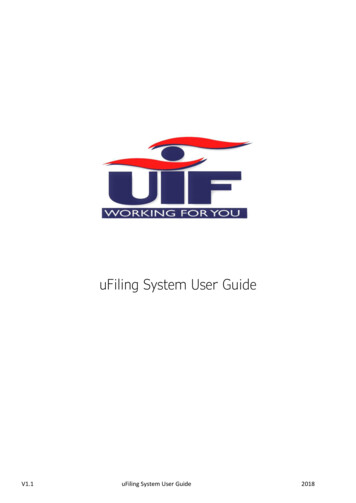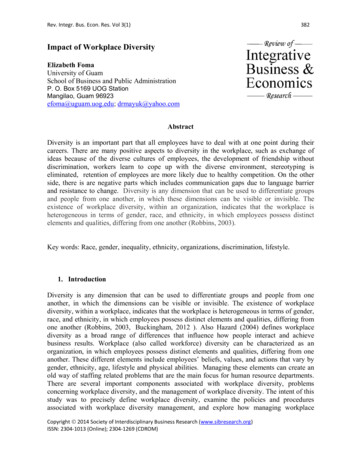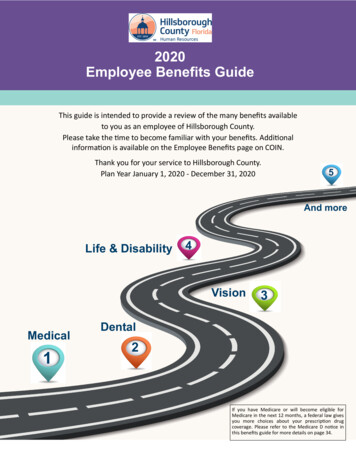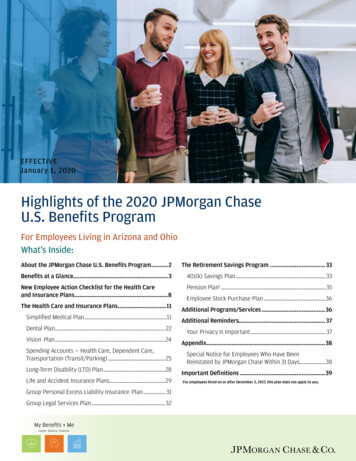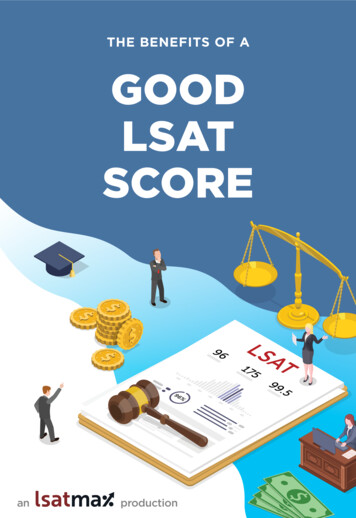
Transcription
THE BENEFITS OF AGOODLSATSCOREanproduction
THE BENEFITSOF A GOODLSAT SCOREEffects on Median Starting Legal Salaries. 1Effect on Law School Financial Aidand Scholarships.5Comparing Two Hypothetical Law Students’Financial Futures.9
Law school is an expensive proposition, even in a thrivingeconomy. From 2019-2020, the cost of full-time tuition andfees at a ranked law school in the United States averaged awhopping 40,244 for residential students. The price tag is evenmore intimidating for top schools. Columbia University, rankedby USNWR as the fourth-best law school in the nation, charged 72,465 for the 2019-2020 school year.If you’re considering spending six figures on three years ofeducation, it’s reasonable to want a return on investment—especially if you anticipate financing your net law school costsmostly by taking out loans. And that’s where your LSAT scorecomes in. The higher your score, the better your likely law schoolROI, and the lower your eventual debt burden.There are two main things a high LSAT score can do for yourwallet, as follows:1. Make you eligible for merit scholarships2. Get you into schools that send many graduates to high-payingemployersLet’s take a look at the second one first.
EFFECTSON MEDIANSTARTINGSALARIESSome LSAT prep companies may imply that law firms base yourstarting salary in part on your LSAT score when you’re a newlawyer. At TestMax, we prefer to tell you the full story and let youmake up your own mind. The truth is, not all legal employers evenask for your LSAT score. And, at the highest-paying law firms,all first-year associates make exactly the same salary. But thatdoesn’t mean a great LSAT score won’t get you a higher salary, bygetting you into schools that give you access to top employers.Lawyers work either in the public or private sector. In the publicsector, you’ll probably make between 35,000 and 65,000,driven more by location and the difference between non-profit &1
government work than by where you went to school. That beingsaid, public sector jobs are highly competitive, and a J.D. from atop school is needed to land a desirable position.Now, if you choose to work for a private employer, the wholeballgame changes. Starting salaries at top biglaw firms can beabove 200,000. But if you don’t go biglaw, you’re likely to makemore like 60,000- 75,000 in your first year at a smaller firm.So how do you land the top-tier biglaw salaries? Glad you asked.The best, and really only, way to work in biglaw is to go to a topschool. It doesn’t absolutely have to be one of the vaunted “T14,”but there are relatively few law schools that send a significantnumber of graduates to top-paying firms.In fact, there are exactly 23 law schools where graduates tie forthe highest median starting salaries in the industry, at 180,000.And the average of students’ median LSAT scores across all 23of those schools is 167.65. Rounding up to 168, that’s a 95thpercentile score—meaning, to get access to schools where thehighest-paying employers hire most, you’ll need to score in thetop 5% of all test-takers.So what happens if you don’t get a 168 or above? Well, salariesdrop pretty quickly with lower LSAT scores. Here’s a table:Median PrivateSector StartingSalaryLSAT Median(Averaged)Number ofSchools 180,000167.6523 100,000158.638 70,000155.2516 50,00015072
A quick Statistics 101 refresher: median means “in the middle,”not “average.” So if a school had 7 graduates, whose starting lawfirm associate salaries were 60,000, 75,000, 80,000, 180,000, 195,000, 200,000, and 205,000, that school’s median privatesector starting salary would be 180,000. (Actually, to simplifymatters and avoid outliers, they just use the 50th percentilesalaries of their recent graduates—but it pretty much works outthe same.) Median is a more accurate measure than “average,”because an average starting salary might come out to somethinglike 90,000, which isn’t a common starting legal salary at all.Now, of course there are outliers, as in any data set. For instance,New York Law School is in the 100,000 median starting salarygroup, but the median LSAT score at NY Law is just 153. However,the school’s first-attempt bar passage rate is just 59%—a full 15%lower than the state average—and only 74% of graduates wereemployed 10 months after graduation not great, considering theaverage student who accrued debt at this law school owes over 142,000.Most schools with high median starting salaries and comparativelylow LSAT medians are similar, and that’s because the numbersthey announce are for graduates employed as law firm associates.The 0 salaries of unemployed grads stuck living with theirparents, or the hourly retail jobs of graduates still struggling topass the bar, don’t count.So, if you want the best possible chance of making a lot of moneyas a lawyer, you need to get into a school with a high medianstarting salary, high bar passage rates, and high employmentrates. And most schools that can boast all three? You guessedit—they’re the same schools that can boast about their 180,000salary medians.3
Take U.T. Austin, for instance. It’s not Harvard, Yale, or Stanford.It’s not even “T14” (this year). But 90% of graduates pass the bar ontheir first try (15% higher than the state average) and 85% of gradsare employed 10 months after graduating. And Austin grads whotook out student loans were indebted to the tune of an averageof 91,000 that’s 51,000 less than New York Law School gradsowed. Yes, employed, 50th-percentile Austin graduates aremaking more money (to the tune of 80,000/year) and they oweless money. That’s the magic of a great LSAT score at work—a 167median, to be precise (14 points above NY Law).So here’s the big takeaway: a high LSAT score is the key to gettinginto top law schools, where you’ll not only have more access tohigh-paying employers, you’ll get an education that gives youa better chance at bar passage and employment. And, you maygraduate with less debt at a higher-ranked law school, even if youdon’t get scholarships which we’ll talk about now.4
EFFECT ONLAW SCHOOLFINANCIAL AID &SCHOLARSHIPSHere’s a dirty little secret about law school: when you sit downfor your first 1L class, the people sitting to the left, right, front,and back of you (or beside, above, and below you in Zoom’s galleryview, perhaps) will all probably be paying a different price for lawschool than you are. Tuition discounting is rampant in the lawschool economy, and the strange thing is, it wasn’t always likethis—according to the 2015-2016 Law School Survey of StudentEngagement (LSSSE), the 70% or so of law school studentsreceiving scholarships these days was “a proportion that wouldhave been unimaginable a decade ago.”5
So what changed? Mostly, after the 2008 Great Recession, lawschools got better at marketing themselves to prospectivestudents. They realized two things: first, that customers respondwell to discounts, and, second, that law school rankings areincreasingly driving students’ enrollment decisions.Picture yourself shopping for a new laptop for law school. Areyou more interested in a 2,199 computer marked down to 1,499this week only, or a 1,499 full-price device that appears to havethe same features? If you’re like most consumers, you’d choosethe product with the higher sticker price, assuming it to be ofsuperior quality and a better deal.The same phenomenon applies to law school. Students aremore excited about getting a 50% scholarship to a school wherefull tuition comes to 40,000 than they would be about paying 20,000 in full-price tuition. A scholarship is an achievementthat can be touted on a resume and shared with friends andfamily. Choosing a school with affordable full-price tuition won’tgarner the same social accolades. So, in order to get more oftheir accepted students to commit and attend, law schools offerscholarships that aren’t true scholarships, because they go tosuch a high percentage of students—they’re more like sale-pricedtuition.Now, let’s talk about ranking. Law schools really, really, reallywant to be ranked highly, especially in the U.S. News and WorldReport rankings, because high-ranking law schools attract moreapplicants and earn more money, not just from tuition and feesbut from alumni contributions. Schools that are just one ortwo spots away from a designation like “top 14” or “top 25” areespecially motivated to boost their rankings. And how can theydo that? By attracting students with high LSAT scores, high UGPA(undergraduate grade point average), and who will boost their bar6
passage & employment statistics post-graduation.That’s why students with high LSAT scores are drastically morelikely to receive “merit scholarship” offers, regardless of whatschool they attend or their other attributes. Let’s take a look atsome more stats from the 2015-2016* LSSSE, shall we?LSAT ScoreRangeProportion ReceivingMerit Scholarships140 and 1-16587%166-18090%Yes, seriously—90% of students with an LSAT score of 166 orabove receive merit scholarships.** Granted, these stats takeinto account all merit scholarship awards; some schools will offerawards as small as 5000 per year to admittees. That’s basicallya consolation prize so nobody has to be the only person in their1L study group admitting to paying sticker price at a law schoolknown for its generous scholarship packages.Still, even when we think about the total net cost of law school(that’s how much you paid, after all forms of financial aid thatyou don’t have to pay back), merit scholarships appear to makea big difference. According to the same LSSSE data, only 35%7
of students expecting to graduate with over 200,000 in debthad received merit scholarships, whereas 76% of studentsanticipating from 1 to 40,000 in law school debt got meritscholarships.So-called “merit” scholarships are, overall, probablybad for students and for the legal profession. They flowdisproportionately towards already-privileged groups, such aswhite students, men, and those who are not first-generationcollege graduates. That’s largely because the best way to land amerit scholarship is by doing well on the LSAT—which tends tocost both time and money, unless you’re one of those rare, nearlymythical “LSAT naturals.”In the long term, law schools should lower their tuition prices forall students and reduce their merit scholarship grants. A situationwhere no two 1L students can be sure they’re paying the sameprice for the same education is unfair and untenable. But, forright now, merit scholarships are a reality of law school life. So,if you don’t want to graduate with 200,000 in debt, you’re goingto need to set yourself up to receive as much merit scholarshipmoney as you possibly can. And that starts with a high LSATscore—which is the only quantitative part of your law schoolapplication you can still control after obtaining your first fouryear degree.8
COMPARING TWOHYPOTHETICALLAW STUDENTS’FINANCIAL FUTURESStatistics can seem pretty abstract. So let’s look at this anotherway, by making up two hypothetical law students. We’ll call oneHigh-Score Hailey, because she got a 169 on the LSAT. The otherone will be No-Prep Nelson, who didn’t do much studying for hisLSAT and got a 155—still above the median, but not as high as hecould have scored with more practice.We’ll pretend their GPAs are the same, so that their LSAT score isthe only difference. And they’re both going to try to pay as littlefor law school as they can, while still making as much money intheir first law firm jobs as possible.9
Let’s say Hailey chooses to attend Washington University in St.Louis, ranked #17 on the latest USNWR list. It also happens tobe the highest-ranked school on USNWR’s list of the ten mostgenerous law schools. Their sticker price is a whopping 57,445—not that far below Harvard’s 65,875 price tag. But St. Louis gives79.3% of applicants a scholarship that covers at least 50% of theirtuition. The median grant for full-time students who receivedaid was 40,000 in the 2018-2019 school year. Hailey is near theirLSAT median of 168, so let’s say she gets the average grant of 40,000, reducing her net tuition to 17,445.As for Nelson, we’re going to send him to the University ofNebraska - Lincoln, tied for 76th in the latest USNWR rankings.They’re also among the top ten most generous law schools, with81.3% of students getting at least a half scholarship. Let’s sayNelson doesn’t already live in Nebraska—most people don’t—sohe’ll be paying the out of state tuition of 36,918. And, just likeHailey, he’s attending a school where he’s one point off the LSATmedian (156, at Lincoln), so we’ll give him the school’s averageaward of 16,221, placing his net tuition at 20,697.Let’s assume both students finance their net tuition plus livingexpenses using loans. Since the economy isn’t doing so hot, we’llgive them an interest rate of 4.66%, which is below the nationalaverage of 5.8%. And, we’ll assume they both end up as totallyaverage students for their schools—they’ll get median salaries andgraduate with median indebtedness.Now let’s see how these choices play out 10
HalleyNelson169155WashingtonSt. LouisU. of Nebraska Lincoln1776Net Tuition(3 years) 52,335 62,001Chance ofBar Passage95.5%93.4%Chance of Employment10 Months AfterGraduation90.2%87.5%Starting Salary 162,500 60,000Indebtedness atGraduation 98,058 62,001***Total Debt Payoff Cost(10 years at 4.66%no extra payments) 122,860 77,683Total Debt Cost as aPercentage of Salary75.6%130%Gross Annual IncomeAfter StudentLoan Payments 150,212 52,236LSATSchoolUSNWR Ranking11
Even after taking on more debt, Hailey winds up with almost 100,000 more to live on each year than Nelson. Of course, that’sbefore taxes, and she’ll probably pay a little bit more in taxes thanher friend in Nebraska but overall, most people would rathertrade places with Hailey, who is in debt to the tune of threequarters of one year’s salary, than Nelson, whose debt burden is1.3x his starting salary.And we haven’t even accounted for these two students’ abilityto invest. Nelson’s not looking like a great risk for a bank andwill have trouble saving for a down payment, so he’ll probably berenting for a few years. But Hailey can probably get approved fora mortgage after a year or two of on-time student loan payments.Hailey can afford to invest in a 401(k) and maybe put some moneyinto the stock market. Nelson will be lucky if he can drop a fewbucks into his savings account for emergencies.Plus, Hailey will have a top-20 law school degree that allows herto interview for jobs around the country. Nelson’s probably stuckusing his law school’s network and the connections he madeduring law school to get jobs in the Lincoln area, where he’s barelymaking more than the median household income of 58,506.The bottom line is: you don’t want to be a No-Prep Nelson.Preparing properly for the LSAT may sound expensive, but alow score could cost you 100,000 or more per year. Or, toput it another way: each of the 14 points by which Nelsonunderperformed Hailey’s LSAT score cost him 7000 in his firstyear as an attorney alone.If part of the reason you’re going into the legal field is to secureyour financial future, a high LSAT score isn’t just a nice-to-have,it’s an absolute must.12
As for how to obtain that score—well, maybe we can help. If you’vemade it this far, please indulge us in a brief sales pitch that mightsave you thousands of dollars.TheDifferenceSome people don’t need to prepare extensively for the LSAT. Forinstance, the naturals we mentioned earlier (who comprise lessthan 1% of test-takers). Or, people who can be fairly certain ofgetting into law school through legacy admissions.For everyone else, there are basically three ways of getting readyto take the LSAT: self-study, hire a private tutor, or buy into anLSAT prep company’s educational model, which may involve groupclasses; self-paced courses; and/or one-on-one or small grouptutoring.LSATMax is in the third category. And we’re definitely not alonethere. There are quite a few companies that promise to help youimprove your LSAT score. Frustratingly, the ferocious curve of theLSAT means that only 1% of test-takers will score 172 or above,even if 100% of test-takers were to study extensively. So whatmakes us think that not only can we help you beat the curve, wecan do so more effectively than our competitors?A few things, actually.We’ve been social distancing since 2010. Now that the novelcoronavirus has made in-person instruction impossible, other testprep companies are scrambling to create online courses based ona curriculum originally designed for group classroom instruction—which, by the way, was never ideal for LSAT students, becausegroup settings necessitate courses that cater to the median13
student, leaving low and high scorers behind. LSATMax, bycontrast, has always offered the same core product: a self-paced,online LSAT prep course. Our curriculum was developed forremote learning. We have far more experience delivering contentto your phones, tablets, and laptops than any of our competitors.The best 99th-percentile instructors. All of our LSAT instructorshave 99th-percentile LSAT scores—and that’s on a real, officialLSAT, not an already-released practice test administered with awink and a nod in a corporate office, like some of our competitorsuse. But we avoid hiring those 1% naturals who didn’t have to workfor their LSAT scores. When you study with our instructors, you’reworking with someone who knows what it’s like to get a lousypractice test score or hit a plateau while studying. They studiedhard for months to achieve their goals, and they can help you dothe same. To attract and retain the best instructors, we pay themwell, let them set their own schedules, and provide a top-notchteam to handle tech support and customer service, so teacherscan focus on teaching.Improve your score or get your money back. LSATMaxguarantees your LSAT score will improve after completing thefull course. That goes even for students who’ve already taken anofficial LSAT—just use your latest score report to establish yourbaseline score. If you don’t get a score increase out of the course,it’s free, period.You might not even have to pay for our course at all. Do youhave a testing fee waiver from LSAC due to financial need? If so,you can get the full LSATMax premium LSAT course for 0.00.Just send us your fee waiver (support@testmaxprep.com) andit’s yours. We can’t force law schools to stop pricing tuitionunfairly by using merit scholarships that force poorer students tosubsidize their wealthier peers. But we can, and do, help people14
who can’t afford costly LSAT prep get the scores they need toaccess those scholarship dollars.Personal tutoring: buy as much or as little as you want, andsplit it with friends. If you choose to purchase private tutoringthrough LSATMax, you can pay by the hour or save with bulkpackages. Even better for the frugal student is our new Tutoringwith Friends program. You can now split tutoring sessions withup to three people, driving the cost as low as 33.33/hour perperson. Bluntly, there’s nowhere else to get high-quality privateLSAT instruction for an hourly rate that low.Lots of free ways to get personal help. We realize not everyLSATMax student can afford to add personal tutoring, even aftersplitting the cost with others. So we also make our 99th percentileinstructors—not a separate B-squad, but the exact same tutorswho cost up to 200/hr for private sessions—available for freein weekly live & recorded Office Hours. They’ll also answer yourquestions on our LSAT message board. And, leading up to everyLSAT administration, we do a bonanza of daily Office Hours. It’sall hands on deck to help our students in the last days before theirLSATs—even tutors who are fully booked months in advance makethemselves available for these special sessions. Not to mentionour weekly podcast, The Legal Level, which is 5-star rated onApple Podcasts and will always be 100% free.Our testing interface is exactly like the real digital LSAT. You’lltake all your practice tests using the exact same functionalityand tools available on the digital LSAT (both tablet version andLSAT-Flex). Realistic testing conditions are critical in order toget practice test scores that accurately predict your official LSATscore, so you know whether or not you’re ready for the test.When the LSAT changes, so do we. This year saw the debut of the15
three-section LSAT-Flex, taken in students’ homes with a remoteproctor. Within days of the announcement, we created a new FlexMode in the LSATMax course that allows students to take Flexstyle practice tests and get scores based on three sections, notfive. That’s the kind of thing you can do quickly when you’re anonline learning technology company, not a classroom companytrying to learn on the fly how to build and release technology.We make money by selling a product people want to buy,not from hedge funds or holding companies. It’s no secretthat standardized test preparation is big business. Like mostindustries, it’s been a target of high-dollar outside investment andacquisitions. Getting acquired by a huge corporation seems likea good thing at first, because it brings in more capital that can beused to grow and hire. But when people who’ve never studied forthe LSAT start running the show and focusing solely on profit—which is what holding companies do—students no longer comefirst. That’ll never happen at LSATMax. We’re a bootstrapped,founder-run company, and you can talk to the founder if youwant. His name is Mehran, he’s a Harvard-educated lawyer, and hemessages you in our app sometimes. (Yes, it’s actually him, muchto the consternation of whoever else is trying to get his attentionwhen he’s busy talking to students.)We’re with you all the way to the Bar Exam. As a companyfounded by a Harvard Law School grad, we know that law studentsneed support even after they ace their LSATs. That’s why wealso offer admissions support (including free webinars on theadmissions process), a 1L study support app, and our BarMaxBar Exam Review course with instructors including HarvardLaw School faculty members along with other highly-respectedattorneys and law professors.If you want to do good things as a lawyer, we’re on Team You.16
Everyone at TestMax is highly accomplished in their field. Weall have lots of options for what kind of work we could be doing.We’re at TestMax because we’re passionate about making thelegal profession more accessible and more equitable. We offerpartial BarMax scholarships to students pursuing careers in publicinterest law. Our Justice in Action program will support 1,000future lawyers from underrepresented populations over the nextfive years, from the day they begin studying for their LSATs to theday they pass the bar.We’re striving to create a world where there are so many goodand decent lawyers in the world that absolutely everyone whoneeds help navigating the legal system can find quality, affordablerepresentation. And where everyone interested in practicing lawcan access and afford the best legal education humanity has tooffer. If that’s a world you’d like to live in—and if, specifically, you’dlike to practice law in that world—we invite you to start your LSATjourney with LSATMax today.*By the way—we’re using 2015-2016 LSSSE data because thissurvey focuses on a different topic each year, and it hasn’t beenprimarily about scholarships since 2015-2016. Still, since lawschools don’t disclose individual scholarship award data, it’s themost objective resource we have for facts about law school meritscholarships.**It should be noted that some of the very highest-rankinglaw schools, such as Yale and Cornell, don’t award any meritscholarships at all, mostly because everyone admitted to a schoollike Yale is likely to have a high LSAT score and UGPA. It would besilly to charge a student with a 98th percentile LSAT score morethan a student with 99th percentile LSAT score—there’s just noreal difference.17
***Nelson’s net tuition is greater than the average indebtednessof Lincoln students of 59,442, which is probably because theschool’s debt averages include in-state students who pay muchlower tuition—so we’ll just be kind to Nelson and say he only tookout loans for tuition, and didn’t spend any more debt-financedmoney during law school, while Hailey also financed 40,000 ofliving expenses. She still ends up better off!18
2019 Law School Salaries & LSATsSchoolMedian Salary(Private)Median 80,000167University of Chicago180,000171Yale180,000173University of Virginia180,000169Fordham180,000164U. of Pennsylvania180,000170Northwestern180,000169Boston College180,000164U. of Michigan Ann Arbor180,000169Boston 69George Washington UC Berkeley180,000168UT Austin180,000167Howard University180,000151University of Southern 0167AVERAGE IN GROUP167.652Santa Clara University100,000155New York Law School100,000153U. of Washington100,000163Southern Methodist U.100,000161American University100,000158Rutgers100,000155U.C. Davis100,000162Indiana U. - Bloomington100,000162AVERAGE IN GROUP158.62519
2019 Law School Salaries & LSATs (Continued)Median Salary(Private)Median LSATU. of the District of Columbia70,000147Texas A&M70,000157Hofstra University70,000153Cardozo-Yeshiva University70,000161U. of Kansas70,000157Quinnipiac University70,000152West Virginia U.70,000153U. of Mississippi70,000155U. of St. Thomas70,000154Cleveland State U. (Marshall)70,000153U. of Alabama70,000164U. of Maryland70,000158Stetson University70,000155U. of Pittsburgh70,000157Southwestern University70,000153St. Louis University70,000155SchoolAVERAGE IN GROUP155.25U. of Wyoming50,000153North Carolina Central U50,000146Western New England50,000148Northern Illinois University50,000149University of Toledo50,000152Campbell University50,000152Florida Coastal50,000150AVERAGE IN GROUP15020
Try The #1-RatedLSAT Prep for Free.Get 10% off when you enroll.Instant & Lifetime AccessDetailed Analytics90 Full Length LSATsWeekly Office Hours99th Percentile InstructorsHigher Score GuaranteeAuthentic Digital LSAT/LSAT-Flex Experience#1 for 3 Years in a RowTo Redeem Visit lsatmax.ioor Call (855) 294-4553COMPREHENSIVE LSAT PREPON MOBILE & WEB
Become AnotherSuccess StoryKyle RymanTexas A&MAnita YandleUniversity ofWashingtonAustin SheehyUniversity ofCentral OklahomaNaader BankiUSCI scored below a 150 on my first practice LSATin November. In June I took the LSAT andscored a 170. I couldn’t have done it withoutLSATMax.The tutorials from LSATMax helped me getmy 99th percentile score! It was great to havethe videos at my fingertips at all times so that Icould study any time I had a moment.LSATMax is my hero! My starting score wasaround a 155-158, and I scored a 170 on theJune LSAT!I used LSATMax to study for the October LSAT.I started out with a diagnostic somewhere inthe 150s, and improved my score to 166 on theOctober test.
Claim Your Free 30-MinLSAT ConsultationEnsure a strong start to your LSAT prep. Schedule your freeLSAT consultation with a 99th percentile instructor.Visit lsatmax.io/consultor Call (855) 294-4553
Some LSAT prep companies may imply that law firms base your starting salary in part on your LSAT score when you’re a new lawyer. At TestMax, we prefer to tell you the full story and let you make up your own mind. The truth is, not all legal employers even ask for your L

